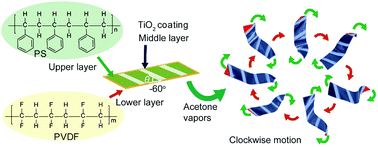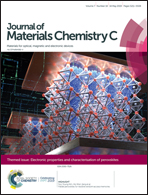Controllable kinematics of soft polymer actuators induced by interfacial patterning†
Abstract
Soft polymer actuators showing controllable shape changes in response to external stimuli can be utilized in self-adaptive devices, sensors, and soft robotics, where a special structure design is normally required to obtain controllability. Herein this work reports a soft bilayer actuator that is composed of a tough stretchable polyvinylidene fluoride (PVDF) layer and a brittle stiff polystyrene (PS) layer. The PS element that increases the flexural modulus of the PVDF layer, together with TiO2 patterns that are located between the PVDF and PS layers instead of traditional surface patterning, endows the composite actuator with controllable motility. Upon exposure to acetone vapor, the PVDF/TiO2/PS actuator generates motions including anticlockwise/clockwise wiggling and forward wriggling. The kinematics mechanism is demonstrated owing to the soft actuator that expands by sorption of acetone vapor from the PVDF side and curves up; the upward ends then curve down by local contraction caused by spatially different acetone desorption. Various soft robots are created to verify the generality of this kinematics mechanism. Such controllable kinematics proceeds well for all PVDF/TiO2/PS soft robots that have different geometries; however, the soft robots move irregularly without interfacial TiO2 patterning structures. The PVDF/TiO2/PS composites with controlled shape deformations have potential for the preparation of acetone vapor-sensing devices.



 Please wait while we load your content...
Please wait while we load your content...